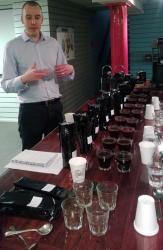In the eighties and nineties, the slow-burning TV romance of ‘the Kenco couple’ elevated the brand to the nations’  favourite, igniting the British love for a steamy mug of instant coffee. This was no ‘Carry on Caffeine’, but the height of middle-class sophistication. But how times and tastes have changed.
favourite, igniting the British love for a steamy mug of instant coffee. This was no ‘Carry on Caffeine’, but the height of middle-class sophistication. But how times and tastes have changed.
The same company now bring us ‘artisan’ blends of freshly-ground beans sealed in pots that allow us to play barista at home, whipping up thimbles of rich, creamy espresso with our new-fangled machines. And today’s darlings of the coffee campaigns are none other than the suitably smooth and sophis’ George Clooney and Penelope Cruz.
This is a clear reflection of where we are as nation when it comes to coffee, something also evident in the myriad roaster-cum-coffee shops popping up in and around the capital, started by young, hip coffee-boffins who craft quality blends from freshly-ground, single-origin beans. For aficionados, names like Nude Espresso, Flat White, Federation Coffee and Prufrock will ring a bell.
The latter was where today’s event took place – continued ‘Pruf’ that us Brits expect a little more from our coffee shops these days. Inside, young hipsters sit on wooden benches sipping their leaf-stamped espressos, Aeropress, or pour-over blends, and the counter is adorned with piles of cakes, brownies and cured-meat sarnies.
Upon arrival, I headed straight for the basement where the hardcore cupping action takes place. This wasn’t to partake in some indecent act, but a coffee-blending masterclass with CafePod blender John Thompson, the face behind CafePod‘s serious single-origin bean-to-blend coffee pods – the only Nespresso-compatible capsules available on the high street.
As John steered us through step-by step process of sourcing, grinding, tasting and blending the beans, his 17 years of industry experience were evident. We began with the cupping – slurping back little glasses of single-origin grounds steeped in water heated (not boiled!) to 94c. John explains the rather uncouth sound effects typical of cupping are symptomatic of the most effective way to taste, spraying the whole palate with the coffee’s complex flavours.
Samples hailed from Latin America – Brazil, Honduras, El Salvador – and, across the water, from Sumatra, India and Zambia, with both medium- and rich-roasts of each. As we tasted lighter roasts, descriptions like ‘white grapefruit’, ‘floral’, ‘citrus’ and ‘boozy orange’ were thrown about. Dark roasts prompted reactions such as ‘tobacco’, ‘dark chocolate’, ‘roasted almond’, and even ‘Bovril’. As proof that at least part of our collective psyche remains unapologetically British, all concurred with the latter.
We learnt these flavours are determined by the specific origin’s geographic location. Much like wine, soil, climate and altitude have a large part to play. In a higher altitude-grown El Salvador, delicate, citrus notes will be present. The Pinot of coffee, if you will. However, it’s the grinding that will ultimately determine the quality of your cuppa – accountable for 80% of the process.
During grinding, the coarseness of each blend is tweaked to ensure it adapts to the espresso machine’s high-pressure method. This removes the oils and emulsifies the coffee, creating that coveted, sea-spume-like crema that crowns an espresso. The result should be a smooth, rich flavour and velvety mouthfeel. To prevent any degredation, an inert atmosphere is needed when packing fresh grounds.
It’s oxygen, we are told, that’s the enemy of fresh coffee – which explains the ubiquitous valve on packets. This keeps oxygen out and releases carbon dioxide. Accordingly, CafePod seals its own pods in an oxygen-free sachet, which ensures the little pack of grounds doesn’t double as an aromatic explosive device. Something of a relief in light of the fact that the next step was to create and take home our very own versions.
Perhaps as the only male in attendance, I had been loudly championing the boldest beans, such as Brazillian, Sumatran and Indian Robusta, although my opinion failed to be heard above the softly swelling chorus of appreciation for delicate El Salvador and medium Zambian. But then the point of today’s lesson was to recognise our preferred flavour profile, enabling us to craft a unique blend.
With each origin laid out in cups, we set about proportioning percentages for a few of our preferred grinds. My personal blend comprised precisely 47% Brazillian dark, 35% El Salvador medium and 18% Sumatra dark. Pleased with the results, I was delighted to discover that my unique blend would be encapsulated and sent home. By this point, the memories of a cup of ‘instant’ were, happily, very much be a thing of the past.
